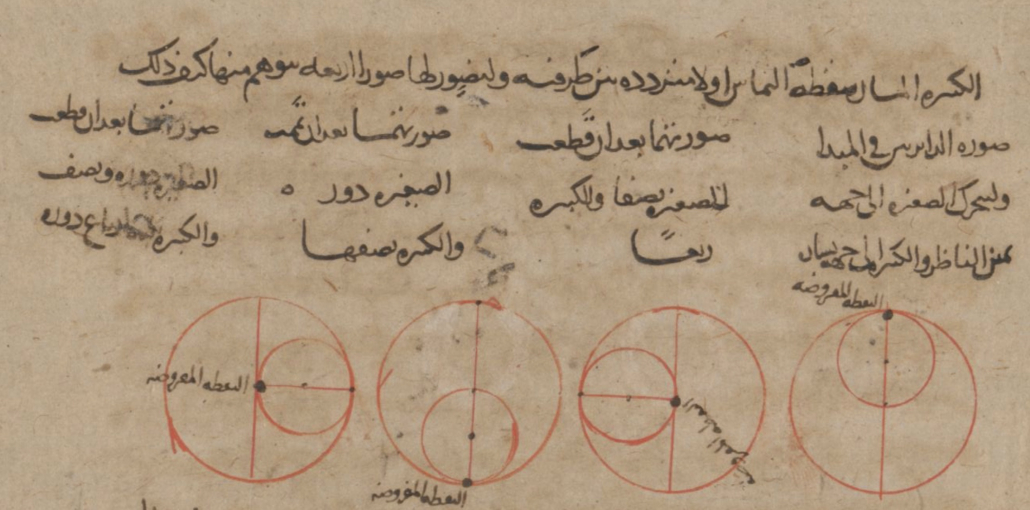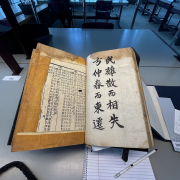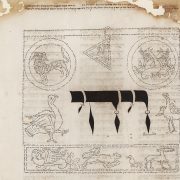Uncovering the history of Islamicate astronomy
Gastbeitrag von Dr. Scott Trigg
Long before our current scientific understanding of the solar system, astronomers as far back as ancient Babylonia recorded observations of the night sky. In an Earth-centered cosmos, the entirety of the heavens seems to rotate around the stationary Earth in a daily motion of rising and setting. However, by observing the stars at the horizon before sunrise or after sunset, it quickly becomes apparent that the Sun, Moon, and planets all have their own irregular motions against the background of the constellations. The challenge ancient Hellenistic astronomers set themselves was to account for this collection of irregular motions by means of a system of uniform circular motions, the only motion considered appropriate to the perfect, eternal celestial bodies. Their efforts resulted in the Almagest of Claudius Ptolemy (2nd c. CE), a masterpiece of mathematical modeling that remained the preeminent text in astronomy for over a millennium, and the standard against which later models were evaluated.
Centuries later, after the appearance of Islam and the emergence of new societies throughout the Mediterranean, Middle East, and Central Asian world, mathematicians and astronomers translated the Almagest into Arabic and began studying it. They raised a number of criticisms and established new observatories to produce updated observations and calculations, all of which led to an innovative tradition of astronomy in the medieval Islamicate world. These texts were produced as handwritten manuscripts and many remain unstudied, but the Staatsbibliothek zu Berlin Oriental Department holds a large collection of manuscripts that is being used by historians of science to understand the rich heritage of Islamicate astronomy. Some manuscripts were dedicated to rich patrons, while others were produced for students and may contain unique marginal notes. All of them hold the potential to provide insights into how astronomical knowledge was taught, criticized, and applied in different locations across Islamicate societies.
Ptolemy’s models were described in terms of flat, two-dimensional circles rather than physical structures in the heavens. However, according to Islamicate astronomers only physical bodies, not “imaginary” circles, could produce motion. Their goal was to maintain or improve the predictive accuracy of Ptolemy’s models, but with a system in which the mathematical models describing the planetary motions could correspond to three-dimensional spheres. Moreover, in order to make accurate predictions, Ptolemy’s models all involved various violations of the principle of uniform circular motion. These issues became all the more pressing to Islamicate astronomers, who argued on philosophical and physical grounds that the celestial spheres simply could not produce the motions Ptolemy described. As a result, Islamicate astronomers produced a series of texts and commentaries setting forth their criticisms of the Almagest models and proposed the implementation of new models that would correct its flaws.
Two episodes in this history stand out in particular, the flowering of scientific communities at the cities of Maragha (in modern-day Iran) in the 13th c. and Samarqand (in modern-day Uzbekistan) in the 15th c. At Maragha, the Islamic astronomer and theologian Nasir al‑Din al‑Tusi prevailed upon the grandson of the Mongol conqueror Chingiz Khan to establish an astronomical observatory. Tusi and other prominent scientists carried out a program of observations that led to the production of an up-do-date table of astronomical data, known as Zij-i Ilkhan-i, which could be used for regulating time and the calendar, predicting eclipses, and calculating other celestial motions for applications such as astrology. Moreover, the scientists discussed ways to correct Ptolemy’s models. Prior to arriving at Maragha, Tusi had already developed a mathematical construction, known today as the “Tusi Couple”, that used the combined motion of two spheres to produce an oscillating motion, which he used to correct problems in the models for the Moon and planets. One of his colleagues invented an alternative mathematical device, the “Urdi Lemma,” which could accomplish similar results. These astronomers described their arguments and ideas in texts, such as Tusi’s al‑Tadhkira fi ‘ilm al‑hay’a (“Memoir on Astronomy”), which were studied and commented on by following generations.

Illustration of Tusi Couple from Nasir al-Din al-Tusi’s al-Tadhkira fi ‘ilm al-hay’a. – Staatsbibliothek zu Berlin, MS. Or. oct. 3568, detail of fol. 18b – CC BY‑SA 4.0
The 15th c. observatory at Samarqand was another significant center of astronomical and scientific activity. It was established by a Sultan of the Timurid dynasty, Ulugh Beg, who in addition to providing funding and support for the observatory and scholars, was himself a highly skilled mathematician. Ulugh Beg gathered astronomers from across the Middle East and Central Asia to his court, and in addition to the revised table of astronomical data they produced we are fortunate to have recorded anecdotes about scholarly life in Samarqand in the form of letters written by the first director of the observatory, as well as a commentary on Tusi’s Tadhkira written by an advanced student, Fathallah al‑Shirwani. These texts, along with other commentaries on the Tadhkira and on related astronomical texts, attest to a dynamic and creative engagement with astronomical problems and to debates within philosophy and theology on the relationship between God, the natural world, and the ability of humans to apply our intellects, experiences, and even experimentation to understand the fundamental order underneath the seemingly unpredictable phenomena we encounter.
Historians are still examining the hundreds of unstudied astronomical manuscripts from this period, but their work should already convince us to reject the old story of a “Golden Age” of Islamicate science followed by a period of “Decline”. In fact, as evidenced by the texts and commentaries produced by scholars at sites such as Maragha and Samarqand, the scientific enterprise continued at a high level of creativity and technical proficiency for centuries longer than previously imagined.
Herr Dr. Scott Trigg, Society of Fellows in the Humanities, The University of Hong Kong, war im Rahmen des Stipendienprogramms der Stiftung Preußischer Kulturbesitz im Jahr 2019 als Stipendiat an der Staatsbibliothek zu Berlin. Forschungsprojekt: „Astronomy and Theology in the post-Classical Islamic Commentary Tradition at Samarqand“

 https://creativecommons.org/licenses/by-sa/4.0/
https://creativecommons.org/licenses/by-sa/4.0/


 Photo: Lukáš Kubík
Photo: Lukáš Kubík![IntroREV Covers of Jacques Noir’s books in the holdings of Staatsbibliothek zu Berlin: left –«Сквозь дымчатые стекла» (1922), [SBB: 426144]; right – «Прищуренный глаз» (1925), [SBB: 434371]. Center: portrait of the author, Iakov Oksner, from «Сегодня» [Segodnia], No. 113, 21 May 1927, National Library of Latvia. – Photos and collage: Katya Knyazeva](https://blog.sbb.berlin/wp-content/uploads/IntroREV-180x180.jpg) Ekaterina Knyazeva
Ekaterina Knyazeva
 . Photo: Ⓒ Linn Ahlgren/Nationalmuseum
. Photo: Ⓒ Linn Ahlgren/Nationalmuseum SBB-PK CC BY-NC-SA 3.0
SBB-PK CC BY-NC-SA 3.0 
Ihr Kommentar
An Diskussion beteiligen?Hinterlassen Sie uns einen Kommentar!